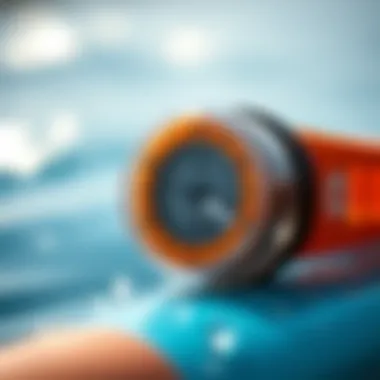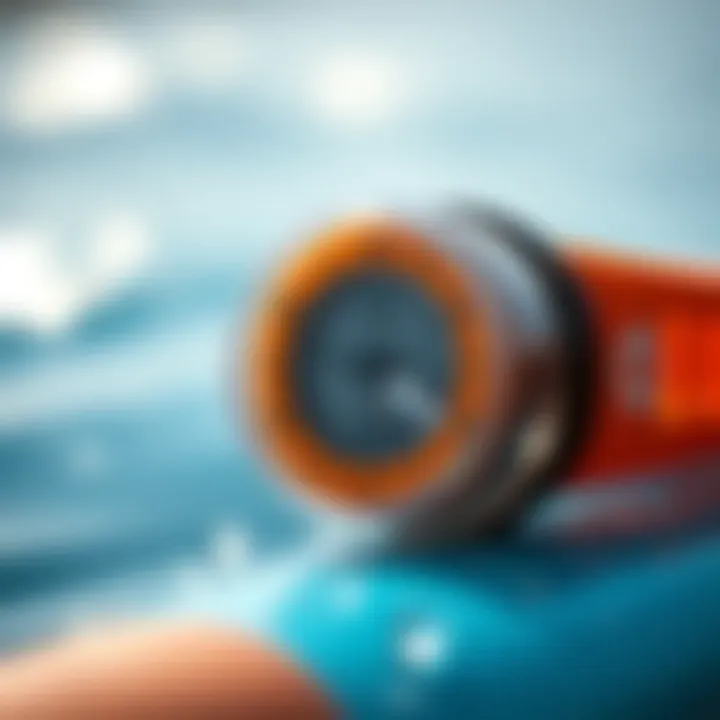Assessing Hydration: Recognizing Dehydration Effects


Intro
Staying properly hydrated is more than just a trend; it’s a crucial aspect of health, striking directly at the heart of physical performance. For surfers and water sports enthusiasts, understanding hydration is akin to mastering a wave—rudimentary yet essential. The link between hydration and athletic output cannot be overstated. When the body is starved of fluids, not only does one feel fatigued, but also agility and reflexes can go out the window. Whether carving through the surf or paddling out for that perfect wave, being aware of hydration levels can mean the difference between riding triumphantly or battling in the shallows.
Dehydration creeps in like a thief in the night. It might start as a little thirst, but if left unaddressed, can morph into a serious hinderance in performance. From diminished energy levels to impaired coordination, a lack of sufficient hydration can profoundly affect a surfer's ability to both enjoy their sport and excel at it. That's why understanding the signs, causes, and assessment methods is pivotal.
In this guide, we'll go through everything from spotting the first signs of dehydration to actionable tips on how to keep your body in peak condition. Exploring various techniques, methods, and the practicalities of hydration can empower surfers, instructors, and anyone who relies on peak physical condition to perform effectively.
The world of surfing is exhilarating, demanding not just skill but physical prowess and endurance. In high-energy sports like surfing, a well-hydrated athlete stays one step ahead. So, grab your favorite water bottle and let’s dive into the essentials of hydration Assessment.
Understanding Dehydration
Dehydration is more than just a passing inconvenience; it can be a critical issue, especially for surfers and other athletes who push their limits against nature's forces. Understanding dehydration is essential as it underpins the very fabric of performance in high-energy activities, where the body’s need for fluids can easily be overlooked. Hydration isn’t a one-size-fits-all matter. It involves an understanding of how much and what types of fluids are necessary for optimal functioning during intense physical pursuits. This section clarifies what dehydration is and why keeping it at bay should be a priority for anyone looking to perform at their best.
Definition of Dehydration
Dehydration occurs when the body loses more fluids than it takes in. Simple idea, right? But the effects can be far-reaching. When we lose water, we're not just losing a couple of glasses; we're losing electrolytes and essential bodily functions can be compromised. Whether it's from sweating it out in the surf, a hot day on the beach, or even just poor drinking habits, losing hydration can lead to significant complications. It's key to grasp that dehydration can be classified in varying degrees, from mild to severe, each having distinct implications on well-being.
Physiological Impact
The effects of dehydration stretch beyond thirst. When the body doesn’t have enough water, numerous physiological processes are affected. For instance, performance can take a hit; studies show that even a 2% decrease in body water can lead to marked drops in physical abilities. You might feel groggy, experience headaches, or find it hard to focus. The heart may have to pump harder, and circulation could suffer, making you more susceptible to cramps and fatigue. It’s a domino effect that can spiral out of control during intense activities like surfing, where quick reflexes and clear thinking are non-negotiable.
Indicators of Dehydration
Recognizing the signs of dehydration is like having a radar that guides you through your hydration journey. Common signs include:
- Thirst: An obvious but often ignored sign. If you feel thirsty, your body is waving a red flag.
- Dark yellow urine: A telltale indicator. Ideally, urine should be pale yellow—like lemonade, not apple juice.
- Dry mouth and lips: When moisture seems scarce, it's a sign that hydration levels are dropping.
- Fatigue or dizziness: Especially after exertion. If you feel your energy draining quickly, take heed.
Identifying these indicators early can be the difference between a successful surf session and an exhausting day spent in the sun. Taking proactive measures and understanding what dehydration looks like can keep you riding high instead of feeling wiped out.
Proper hydration is not just about drinking water; it's about maintaining a balance that supports your overall physical performance and health. This understanding can lead to better preparation and enhanced endurance out on the waves.
By tackling dehydration head-on, surfers and other athletic enthusiasts can ensure that they remain at the top of their game—slicing through waves and enjoying every moment without the nagging effects of fluid loss.
Symptoms of Dehydration
Understanding the symptoms of dehydration is crucial for anyone who engages in physical activities, such as surfing. Surfers, in particular, often find themselves exposed to sun and saltwater, which can increase their risk of becoming dehydrated. Recognizing the signs early can make a significant difference in performance as well as overall well-being.
Mild to Moderate Symptoms
When dehydration sets in, the initial indicators are typically mild to moderate, yet they can easily be overlooked. These symptoms may include:
- Dry mouth and throat
- Increased thirst
- Fatigue or feeling unusually tired
- Slightly reduced urine output, occasionally dark in color
- Mild headaches
- Dizziness or light-headedness after standing up quickly
At this stage, it is often easy to remedy the situation with just a few gulps of water. However, if ignored, these minor inconveniences can snowball into greater issues. For surfers, this means decreased performance on the waves, diminishing stamina, and a slower recovery post-session. Keeping an eye out for these signs can prevent more serious consequences down the line.
Severe Symptoms
Moving beyond the mild indicators, severe symptoms warrant immediate attention. The body can throw up some serious red flags when it’s running on empty. These symptoms may include:
- Very dry skin that lacks elasticity
- Rapid heartbeat or breathing
- Inability to produce urine or a total absence of urine
- Extreme thirst that might feel unquenchable
- Confusion or irritability
- Vomiting or persistent nausea
At this point, the body is signaling distress, and it becomes imperative to address the dehydration issue immediately. Ignoring these severe symptoms can lead to serious health complications, such as heat exhaustion or heat stroke, particularly when out in the blazing sun. For surfers, tackling these symptoms quickly can be the difference between riding the waves and spending the day drying out on the beach.
Long-Term Effects
Chronic dehydration can have repercussions that extend far beyond just feeling thirsty. For surfers and high-demand athletes, ongoing dehydration affects both physical and mental performance. Potential long-term effects include:
- Decreased endurance and muscle function
- Poor recovery times after rigorous activity
- Impaired cognitive function, such as decreased focus and poorer reaction times
- Potential kidney damage
Furthermore, dehydration can also impact joint health, leading to an increased risk of injury while surfing. The body relies on proper hydration to keep joints lubricated and functioning optimally. This highlights the importance of maintaining hydration consistently, not just during the activity, but in everyday life as well.
Maintaining optimal hydration is not just a matter of comfort but is vital for safety and performance in sports, especially for those who embrace the ocean's challenges.
In sum, recognizing the myriad symptoms of dehydration—from the subtle hints of mild dehydration to the critical alarms of severe cases—enables surfers and other athletes alike to manage their hydration effectively. Ignoring the body's signals could lead to diminished performance or even serious health risks, making it imperative to stay well-informed about hydration needs.
Methods for Assessing Hydration
Understanding hydration goes beyond mere thirst. To maintain peak performance, whether you’re riding waves or enjoying outdoor adventures, it’s crucial to keep your body adequately hydrated. This section delves into various methods that can serve as reliable indicators of hydration levels.


The significance of these assessment methods cannot be overstated. They empower individuals, particularly surfers and outdoor enthusiasts, to gauge their hydration status effectively. With multiple strategies available, you can tailor your approach to your routine, ensuring that hydration fits seamlessly into your lifestyle.
Self-Assessment Techniques
Self-assessment techniques are a straightforward way to keep tabs on your hydration without the need for specialized equipment. Knowing your body well can be your first line of defense against dehydration. Some practical techniques include:
- Thirst Awareness: Being in tune with your thirst cues is fundamental. Don’t wait until you’re parched to drink. Instead, maintain a steady intake of fluids throughout the day.
- Body Weight Monitoring: Weighing yourself before and after playing can provide insight into fluid loss. For each pound lost, it’s advisable to drink about 16 to 24 ounces of water to rehydrate appropriately.
- Daily Routine Observations: Make note of how your body responds to different conditions—during a vigorous surf session, are you feeling fatigued or sluggish? Monitoring energy levels can help determine whether you’re drinking enough.
Keeping a hydration journal may also serve valuable by tracking your fluid intake and how you feel throughout your activities.
Urine Color Analysis
Urine color analysis is arguably one of the simplest yet effective methods of assessing hydration. By observing the shade of your urine, you can gain immediate insights into how well-hydrated you are. Here’s a quick guideline to interpreting urine color:
- Clear to Pale Yellow: Generally signifies adequate hydration. Keep going with this fluid intake!
- Dark Yellow to Amber: Indicates that you may need to drink more water. Take notice and up your intake accordingly.
- Brownish or Extremely Dark Yellow: This could mean severe dehydration and may require immediate action. Drink fluids right away and consider consulting a healthcare professional if symptoms persist.
Skin Turgor Test
The skin turgor test can be a practical method for anyone concerned about dehydration. This simple skin pinch test helps evaluate skin elasticity, an indirect indicator of hydration levels. Here's how you can perform it:
- Pinch the skin on the back of your hand or forearm.
- Release it and observe how quickly it returns to its original position.
- If the skin snaps back promptly, hydration is likely adequate. If it takes time or appears to stay tented, it could indicate dehydration.
This test offers a quick visual reference to gauge hydration levels, especially for those engaged in high-energy sports where quick assessment is vital.
Hydration Testing Tools
Understanding one’s hydration status is paramount when it comes to physical performance, especially in high-energy sports like surfing. Various hydration testing tools can serve this purpose effectively. They highlight not only how much water one should be consuming but also provide insights into the effects of hydration levels on overall health and athletic performance. Here are some prominent tools that can help enthusiasts stay on top of their hydration game.
Portable Hydration Monitors
A portable hydration monitor is a compact device designed to measure the hydration levels of the body quickly and accurately. These devices often utilize bioelectrical impedance analysis, or BIA, to provide a detailed overview of body water percentages. Generally speaking, the importance of these monitors is rooted in their accessibility; lightweight and often wallet-friendly, they can easily fit into a surfer's bag, making hydration checks effortless before hitting the waves.
- Benefits of Portable Hydration Monitors:
- Instant feedback on hydration levels, helping surfers adjust their intake on-the-go.
- Ability to track changes over time, which can indicate trends and deficiencies that might require more serious attention.
- Some models offer features like integration with smartphones, allowing for detailed analytics and reminders.
These tools create a more tailored approach to hydration management, enabling users to personalize their strategies according to their unique needs.
Body Composition Analyzers
Body composition analyzers take hydration a notch higher by offering insights beyond just water levels. This technology typically provides data on muscle mass, fat percentage, and overall body composition. Hydration is intricately linked with these elements, as both improper hydration and overhydration can influence performance.
Using a body composition analyzer, surfers can understand:
- Their water retention, crucial in accurately gauging how much hydration is sufficient for them.
- Changes in muscle and fat levels that might occur due to varying hydration practices or dietary adjustments.
- The balance of electrolytes in their body, which affects both performance and recovery.
For instance, a lighter athlete maintaining optimal hydration has a better chance of achieving peak performance compared to a more substantial individual who is either over-hydrated or dehydrated.
Mobile Apps for Hydration Tracking
While physical devices are effective, the advent of technology has ushered in a new era with mobile apps that can track hydration levels. These applications provide a user-friendly platform for individuals to monitor their daily water intake. Many of them feature customizable settings, where surfers can input their weight, activity level, and even the environmental conditions to get personalized hydration recommendations.
Some compelling features typically include:
- Daily reminders to help users stay consistent with their hydration, ensuring they don’t overlook this fundamental need.
- Ability to log water consumption throughout the day seamlessly, which creates a visual representation of their hydration habits.
- Integration with fitness tracking devices to provide holistic analysis, tying hydration to performance metrics.
By implementing these apps, surfers not only ensure they’ve got enough water in their system but can also adjust their strategies based on real-time feedback.
"Understanding hydration isn’t just a matter of gulping water; it’s about knowing your body and how it operates in various conditions. Using the right tools allows you to hit the waves with confidence."
Challenges in Hydration Assessment
Assessing hydration is not just a walk in the park; it’s a nuanced journey that can throw anyone for a loop. This section dives deep into the specific hurdles one might encounter while trying to gauge fluid needs accurately. There’s a lot more to it than just drinking water before hitting the waves or after a surf session. Recognizing these challenges is vital for surfers and sports enthusiasts who wish to maintain peak performance.
Variability in Fluid Needs
Fluid needs can vary like a surfer’s choice of board, relying heavily on individual differences. Some folks might require more water, while others can get by with less. Factors contributing to this variability include:
- Body Composition: Weight and muscle mass can significantly affect hydration needs. Heavier individuals or those with more muscle often need to drink more.
- Age Factors: As we age, our bodies may lose the ability to sense thirst, meaning older surfers might not drink enough if they aren't vigilant.
- Gender Differences: Males typically have higher fluid needs than females due to differences in body structure and activity levels.
- Health Conditions: Certain medical situations can impose additional demands for hydration. Conditions like diabetes or kidney issues require careful monitoring and increased fluid intake.


Understanding these nuances is crucial, as relying on a one-size-fits-all approach to hydration can lead to mishaps on the surfboard.
Influence of Weather Conditions
Just like the way ocean waves hit the shore, weather insanity can drastically impact hydration needs. Hot, humid days make anyone feel like they’ve just run a marathon even if they’re just lounging at the beach. Here are some weather factors to consider:
- Heat: High temperatures can cramp your style, leading to increased sweating and a higher risk of dehydration. Surfers often forget to hydrate adequately when the sun is shining bright.
- Humidity Levels: In humid conditions, sweat doesn’t evaporate as quickly. This could trick the body into thinking you’re well-hydrated when you may actually be losing water in sweat.
- Wind: Windy conditions can escalate dehydration rates due to moisture loss from the skin. It’s easy to overlook this factor when riding the waves on particularly blustery days.
Recognizing how these elements affect hydration can help surfers make better decisions when heading out.
Effects of Physical Activity
Physical exertion alters hydration needs, often in unexpected ways. It’s not merely enough to drink water after a surging session; one needs to consider the following:
- Duration and Intensity of Surfing: Longer and more intense sessions draw on your fluid reserves. The more exertion, the higher the water lost.
- Fitness Level: Well-conditioned athletes may sweat more efficiently, but this doesn’t mean they need less fluid. It can actually mean they need to hydrate even more, as they may push themselves harder.
- Rest Intervals: During breaks, surfers often forget to hydrate as they catch their breath. This can set the stage for dehydration in later stages of activity.
Ultimately, being aware of how each of these factors influence hydration can help navigate through challenges and improve overall surfing performance. Proper planning can mean the difference between a stellar surf session and an exhausting struggle in the sun.
"An ounce of prevention is worth a pound of cure."
Remember to create a balance between fluid intake before, during, and after activity. Staying ahead of dehydration helps ensure you’re riding high on the waves rather than struggling just to finish your session.
For more detailed insights, you can check out resources like CDC Hydration Guidelines or explore discussions on hydration strategies on platforms like Reddit for real-world tips.
Hydration Strategies for Surfers
Surfing is not just a thrilling sport; it’s a full-body workout that demands a lot from your body. Staying properly hydrated while catching waves is essential to optimize performance and ensure safety. Dehydration can sneak up on you, especially in the sun, wind, and saltwater. Here, we outline key hydration strategies designed specifically for surfers.
Pre-Surf Hydration
One of the most critical aspects of hydration for surfers is ensuring an adequate intake before hitting the waves. It’s a good idea to drink a decent amount of water at least two hours before you plan to surf. This gives your body time to absorb the fluids and get you primed for action. Keeping a water bottle handy while preparing your gear is wise; it serves as a reminder to take sips intermittently.
- Sports Drinks: If you’re going for an extended surf session, consider consuming electrolyte-fortified drinks. They can help replenish minerals lost through sweat.
- Avoid Heavy Meals: Don’t make the mistake of indulging in a heavy breakfast right before surfing. Too much food can draw blood to your stomach for digestion, leaving less for your muscles.
“Hydration is like oil in a well-tuned engine; without it, performance drops.”
Hydration During Surfing
Once you’re out on the water, keeping hydrated becomes a bit tricky but incredibly vital. Many surfers underestimate their need for hydration while they’re engaged in the sport. Here’s how to maintain your hydration levels:
- Sip Water: Bring a collapsible water pouch or a waterproof hydration system. Taking small sips every 15 to 30 minutes can keep your hydration in check.
- Temperature Regulation: Be aware of how weather conditions affect your hydration needs. On hotter days, you may need more water than on cooler days.
- Saltwater Awareness: Saltwater can exacerbate dehydration. After all the time spent in the water, don’t forget that you still need to replenish sweat losses with fresh water.
Post-Surf Recovery
After an exhilarating surf session, the body craves recovery, and hydration plays a significant role here as well. Once you’re back on land, enhancing recovery through proper hydration should be your priority.
- Rehydrate with Purpose: Within 30 minutes of your session, drink more water. If your session was particularly strenuous, consider a recovery drink that includes electrolytes to help balance your system.
- Eat Water-Rich: Including water-rich foods post-surf can help accelerate rehydration. Items like watermelon, cucumbers, and oranges not only hydrate you but also provide vital nutrients.
- Rest and Reflect: Take some downtime to let your body recuperate. After a long day of surfing, your body will have used energy reserves and hydration. Balance is key.
In summary, pay attention to hydration by planning ahead and being consistent. Whether you are preparing for the waves, clambering onto your board, or winding down after riding, maintaining proper hydration strategies can make all the difference in your surfing experience.
Dietary Considerations
Diet plays a pivotal role in hydration. It's not just about drinking water; the food you consume can significantly contribute to your body's fluid balance. For surfers and active individuals, understanding dietary considerations is crucial. This section delves into two main components: water-rich foods and maintaining an electrolyte balance. Both elements serve to fortify hydration efforts beyond simple water intake.
Water-Rich Foods
Incorporating water-rich foods into your diet can be an effortless way to boost hydration. Produce like cucumbers, watermelon, and oranges are not just refreshing; they provide substantial water content that supports your overall fluid intake. Consider the following:
- Cucumbers: Over 95% water, cucumbers are excellent to munch on before hitting the waves.
- Watermelon: At about 92% water, watermelon is another summer favorite that helps quench thirst while being low in calories.
- Spinach: While not often recognized, spinach holds about 91% water, providing hydration and nutrients.
These foods act as natural hydrators and can be easily integrated into snacks and meals. Adding a salad or slice of fruit can help meet daily hydration goals without requiring a conscious effort to drink more water.
Eating these items often can assist surfers to stay hydrated even when they might not feel thirsty. Hydration isn’t always about a glass of water; it encompasses a holistic approach.
Electrolyte Balance
Electrolytes are essential for maintaining optimal hydration levels, especially during physical exertion. They play a key role in fluid balance, nerve function, and muscle contraction. Certain foods provide these vital minerals and should regularly be part of your diet:
- Bananas: Rich in potassium, bananas help replenish lost electrolytes after a surf session.
- Sport Drinks or Coconut Water: Better known as quicker replenishing options, these drinks restore electrolytes effectively.
- Nuts and Seeds: Almonds, walnuts, and chia seeds contain magnesium and help in maintaining electrolyte levels.


Failing to maintain proper electrolyte balance can lead to muscle cramps and fatigue. Consider this:
"To maximize your surfing performance, keep an eye on your electrolytes. Hydration isn't solely about fluids; it’s the ratio of fluids to electrolytes that matters."
In essence, merging water-rich foods with an understanding of electrolyte balance creates a foundation for robust hydration strategies. Recognizing these dietary factors can not only improve hydration but also enhance overall health and athletic performance.
By making conscious efforts to include these elements in a pre-surf diet, surfers can better protect themselves from the adverse effects of dehydration, paving the way for more enjoyable and productive surfing experiences.
Common Misconceptions about Hydration
Hydration is often surrounded by various assumptions and myths that can lead to misinterpretations of how crucial it is to maintain proper fluid levels in the body. These misconceptions can particularly affect groups like surfers, who need to ensure they are in top shape to cope with the demands of their sport. Understanding these myths is not only vital for improved performance but also for overall health. By clearing the fog of confusion, we can foster better hydration habits that will benefit both daily life and athletic pursuits.
Myths vs. Facts
There are numerous myths surrounding hydration that can skew people’s understanding of what it really means to stay hydrated. Let’s dissect a few of the more prevalent ones:
- Myth: You need to drink eight glasses of water a day.
Fact: Hydration needs are highly individual and can depend on factors such as body size, activity level, and climate conditions. Some may need more, while others can get by with less. - Myth: Thirst is an accurate indicator of hydration.
Fact: While thirst can signal a need for water, it’s not always reliable. By the time you feel thirsty, you may already be slightly dehydrated. Paying attention to urine color can be a better gauge of hydration. - Myth: All beverages are equally hydrating.
Fact: While water is the best hydrator, beverages with high sugar, caffeine, or alcohol content can have a diuretic effect. These can lead to increased fluid loss, counteracting their hydrating properties.
Understanding these myths can empower surfers and enthusiasts alike to make informed choices, enhancing their performance and health.
Caffeinated Beverages and Hydration
Caffeinated beverages have been the subject of debate within the hydration conversation. Some believe they shouldn’t be counted towards fluid intake, while others are more lenient about their role. Let’s sift through the facts:
- Caffeine and Diuresis: It’s true that caffeine can have a mild diuretic effect, meaning it may increase urine output. However, the impact is often overstated. Regular consumers of caffeine develop a tolerance, which minimizes its dehydrating effects.
- Hydration from Coffee and Tea: Surprisingly, beverages like coffee and tea can contribute to daily hydration. They contain a substantial amount of water and can therefore be included in fluid intake, though moderation is key.
- Benefits in Moderation: For active individuals, caffeine may even enhance performance. It can improve endurance and focus during workouts, including surfing. But it should not replace plain water, especially in hot conditions.
To sum it up, it’s essential to view caffeinated beverages within a larger context of daily hydration efforts. Use them wisely, and don’t forget to drink water. Staying aware of these details helps ensure that hydration practices are optimal for athletic performance.
"Hydration isn't just about drinking water; it's about making smart choices for your body and its needs."
For further information on hydration and its effects, you can check resources like Wikipedia or explore studies found on PubMed. By remaining educated, you'll not only enhance your own hydration practices but can also guide others towards better choices.
The Role of Hydration in Sports Performance
Understanding hydration's role in sports performance is paramount, particularly for those engaged in physically demanding activities like surfing. Proper hydration influences not just how an athlete feels, but it also directly affects their physical capabilities. Being well-hydrated is like oiling a well-used machine; it ensures smooth operation and peak performance.
When it comes to sports, hydration serves several critical functions in the body:
- Thermoregulation: Water is essential in regulating body temperature. During intense physical exertion, such as paddling out on a surfboard, the body heats up. Sweating, a cooling mechanism, requires adequate hydration to be effective. Dehydration can jeopardize an athlete’s ability to maintain a safe body temperature, leading to heat exhaustion or heat stroke.
- Muscle Performance: Dehydrated muscles fatigue faster than well-hydrated ones. Sufficient fluid intake increases muscle endurance and strength, allowing surfers to remain in the water longer without succumbing to fatigue. Muscle cramps, often exacerbated by dehydration, can hinder performance and ruin a good day of surfing.
- Joint Lubrication: Water acts as a lubricant for joints, aiding in smooth movement. Adequate hydration supports synovial fluid production, which cushions joints during explosive movements, such as duck diving under waves or performing aerial maneuvers.
In summary, hydration is not merely a matter of quenching thirst; it is a vital contributor to overall sports performance. By ensuring proper fluid intake, athletes can enhance their capabilities in more significant ways than they might realize.
Physical Benefits of Proper Hydration
The physical benefits of proper hydration cannot be understated, particularly in high-energy sports like surfing. Here’s what happens when a surfer maintains good hydration levels:
- Enhanced Endurance: Sufficient hydration improves stamina, allowing surfers to paddle out repeatedly without feeling drained. This is key when waiting for and catching that perfect wave.
- Improved Strength: Hydration boosts muscle function, leading to better strength, which is critical for paddling, balance, and performing tricks.
- Quicker Recovery: Proper hydration speeds up recovery post-activity, relieving soreness and stiffness faster than when hydration is neglected. This means surfers can hit the waves again soon after without lasting discomfort.
- Injury Prevention: Staying hydrated may lower the risk of strains, sprains, and muscle injuries. Proper hydration ensures that muscles and connective tissues are pliable and resilient.
Mental Clarity and Focus
Hydration also plays a significant role in maintaining mental clarity and focus, attributes that surfers need while negotiating the unpredictable ocean. The brain is roughly 75% water, and even minor dehydration can cause cognitive impairments, impacting decision-making and reaction times. This mental aspect of hydration includes:
- Concentration: A well-hydrated brain can process information and make decisions quicker, crucial when navigating waves and executing maneuvers.
- Reaction Time: Dehydration can slow reaction times, potentially putting surfers in dangerous situations – missing a wave or failing to dodge an oncoming surfer.
- Mood Regulation: Dehydration can lead to fatigue and irritability, affecting not only performance but also the enjoyment of the surf session.
Staying hydrated is often the unsung hero behind athletic success. By taking hydration seriously, surfers can ensure they are not only riding the waves but also riding them at their best.
Ending and Recommendations
In this discussion of hydration and dehydration, the significance of remaining hydrated cannot be stressed enough. Recognizing personal hydration levels, understanding the symptoms of dehydration, and implementing efficient hydration strategies can dramatically affect wellbeing and performance, especially for those engaging in high-energy activities like surfing. It boils down to the fact that even mild dehydration can impair cognitive function, physical performance, and recovery. Being proactive in hydration practices isn’t just about quenching thirst; it also protects against potential health risks and boosts overall effectiveness whether in sports or daily life.
Effective hydration techniques, such as incorporating water-rich foods into your diet or leveraging technology like hydration monitoring apps, allow individuals to take charge of their health. As various factors influence fluid requirements—age, physical activity, and climate—customization of hydration strategies is essential. With a solid understanding of their body's needs, surfers and outdoor enthusiasts alike can make informed decisions, ensuring they maintain optimal liquid levels in diverse conditions.
Summary of Key Points
- Understand symptoms: Recognize the warning signs of dehydration, such as fatigue or dry mouth, and don’t ignore them. Addressing little clues can prevent major issues.
- Assessment tools: Utilize techniques like urine color analysis or skin turgor tests. These methods help individuals gauge their hydration status effectively without needing costly equipment.
- Personal strategies: Consider factors like local climate and individual activity levels when devising a personalized hydration plan.
- Nutrition matters: Include foods rich in water content, such as cucumbers and oranges, in your diet to complement hydration efforts. Electrolytes play a crucial role too, especially during extended physical exertion.
- Hydration technology: Embrace modern tools to track hydration levels and meet personal hydration goals. There are myriad apps and devices available that make this easier than ever.
Future Considerations for Hydration
As new research emerges, continuous evaluation of hydration strategies will be paramount. Attention to the following aspects can further enhance hydration practices:
- Technology Advancements: Future hydration monitoring tools can integrate biofeedback and real-time analytics to offer tailored hydration advice based on body responses during activities.
- Behavioral Insights: Understanding how to change hydration habits is essential. Future studies might explore both psychological and physiological elements influencing hydration behavior among athletes and leisure enthusiasts.
- Nutritional Research: More insights into hydration impacts of various diets, especially those followed by athletes, may redefine how we approach fluid intake recommendations moving forward.
"Hydration is not just about drinking water; it's about supplying the body with what it needs to function at its best in every situation."
- Climate Adaptation: As climate patterns shift, the dynamics of hydration needs may also change, urging frequent reassessment of hydration protocols in outdoor sports settings.



